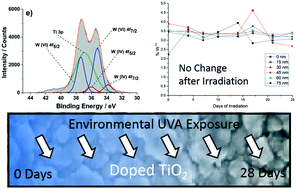Dopant stability in multifunctional doped TiO2's under environmental UVA exposure†
Abstract
We present a UV irradiation study of three nanomaterials which have been investigated and published by peer review previously, specifically tantalum, tungsten and phosphorus doped TiO2. These nanomaterials have been previously synthesised, characterised and designed with specific applications in mind, from photo-catalysts to transparent conducting oxides (TCO's) for use in solar cells and touchscreens. We show in this work, using X-ray photoelectron spectroscopy (XPS) that under sustained levels of environmental UVA Irradiation (0.42 mW cm−2) Ta5+ and W6+ substitutional doped TiO2 exhibits little to no variation in dopant concentration and distribution as a function of irradiation time. Interestingly P5+ and P3− co-doped TiO2 experiences a pronounced and nuanced change in dopant distribution and concentration across the surface through to the bulk as a function of irradiation time. Combined with our previous work with nitrogen doped TiO2, whereby 28 days of environmental UVA irradiation causes interstitial dopant loss and the attrition of functional properties, these results demonstrate that much is still to be understood regarding dopant stability in metal oxides such as TiO2 under environmental conditions.



 Please wait while we load your content...
Please wait while we load your content...